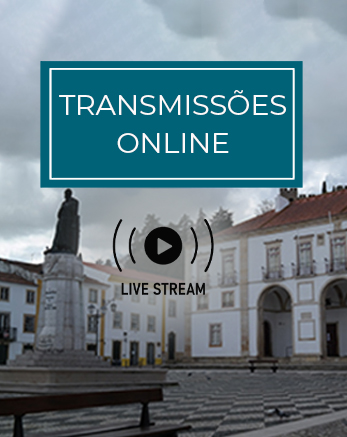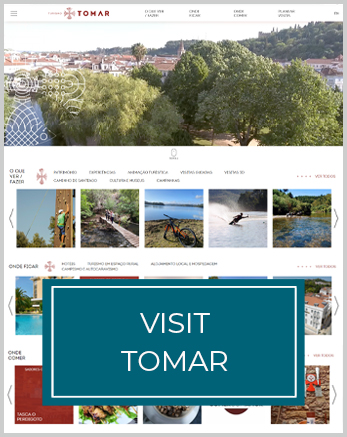Património
- Detalhes
- Atualizado em 01-10-2019
Capelas
Capela de Santa Iria

A igreja da lendária padroeira de Tomar contém um admirável calvário em pedra e uma profusa decoração alusiva aos símbolos do Espírito Santo no apainelado da Capela-Mor.
A linguagem da Renascença Coimbrã é realçada pelo pórtico e pela janela ao gosto de Nicolau Chanterène. Interiormente é revestida por azulejos ponta de diamante, do século XVII. O retábulo de Cristo crucificado é atribuído a João de Ruão.
O Arco das freiras é a passagem aérea entre as Freiras Clarissas do Convento de Santa Iria e o antigo Palácio de Frei António de Lisboa.
Morada:
Rua Marquês de Pombal
2300-510 Tomar | PORTUGAL
Horário
Inverno (Outubro a Abril):
4ª Feira a Domingo, 14h00 às 17h00
Verão (Maio a Setembro):
4ª Feira a Domingo, 15h00 às 18h00
Encerrado dias de feriado, 1 de janeiro, 1 de maio e 25 de dezembro.
Santa Iria Chapel
The church of the legendary patron saint of Tomar has a remarkable stone Calvary and, in the panelled main chapel there is an elaborate decoration allusive to the symbols of the Holy Spirit.
The Coimbran Renaissance language is emphasised by the portico and the Nicolau Chanterène window. The inside is covered in diamond tipped 17th century tiles. The altarpiece of Christ on the Cross is attributed to João de Ruão.
Arco das Freiras is the aerial passage between the Clarissa Nuns of the Santa Iria Convent and the former Palace of Friar Anthony of Lisbon.
Schedule
Winter (October to April):
Wednesday to Sunday, 2pm to 5pm
Summer (June to September):
Wednesday to Sunday, 3pm to 6pm
Closed on public holidays, Jan. 1, May 1 and Dec. 25.
Capela de São Gregório
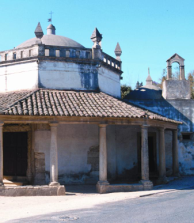
Construção quinhentista de planta circular dedicada a S. Gregório Nazianzeno, teólogo que provou a divindade de Jesus.
Destaca-se o portal manuelino rectangular, sobriamente decorado e abrigado pela galilé que circunda três lados da capela. Os painéis de azulejos setecentistas são originários do Convento das Trinas de Lisboa.
Morada:
Largo Cândido dos Reis
2300-908 Tomar | PORTUGAL
Horário:
Temporariamente encerrada
São Gregório Chapel
A 16th century building with a circular design, dedicated to S. Gregório Nazianzeno, a theologist who proved the divinity of Jesus.
Worthy of note is the rectangular manueline portal, which is soberly decorated and protected by a porch that goes round three sides of the chapel.
The 18th century tile panels originally came from the Convento das Trinas in Lisbon.
Schedule:
Temporarily closed
Capela de N.ª S.ª da Conceição

Pequena igreja basilical de três naves destinada a capela funerária de D. João III, o rei que ordenou a sua construção em 1547.
Concebido por João de Castilho, este belo exemplar do classicismo italiano é a melhor evocação da arte greco-romana na Península Ibérica.
Destaca-se a implementação urbana florentina, a sobriedade austera das proporções, as janelas perspectivadas segundo a orientação solar e, no interior, a articulação dos volumes entre as naves e o transepto, a vibração dramática da iluminação natural e a decoração coríntia dos capitéis.
Morada:
Estrada Dr. Vieira Guimarães
2300-000 Tomar | PORTUGAL
Our Lady of the Conceição Chapel
A small basilican church with three naves, built as a funeral chapel for D. João III, the king who ordered that it be built in 1547.
This fine example of Italian Classicism, conceived by João de Castilho is the best evocation of Greek - Roman art in the Iberian Peninsula.
The application of the Florentine urban style is noteworthy, as are the austere sobriety of the proportions, the windows positioned according to the direction of the sun, and, inside, the interweaving of objects between the naves and the transept, the dramatic vibration of natural light and the Corinthian decoration on the capitals.
Chapel built between 1532 and 1540 in pure Renaissance style, begun by João de Castilho and finished by Diogo de Torralva. It was intended to be the burial chapel of King John III. Its beautiful and clear architecture turns it into one of the most remarkable early Renaissance buildings in Portugal.
Capela de N.ª S.ª da Piedade
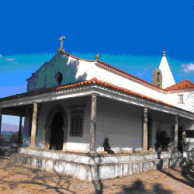
Ermida da Senhora da Piedade ou do Monte mandada edificar pelo Alcaide de Óbidos no século XIV.
Ao portal em ogiva acede-se por uma galilé alpendrada.
Foi restaurada e modificada em 1613 pelo juiz do povo Bernardo Ortiz Ochoa.
Os azulejos azuis e brancos enxaquetados são do século XVII, e o terraço e a escadaria de meados do século XIX.
Morada:
Estrada Nova das Atalaias
2300-000 Tomar | PORTUGAL
Our Lady of the Piedade Chapel
The former chapel of Nossa Senhora da Piedade our do Monte that Alcaide de Óbidos had built in the 14th century.
You enter the covered porch through an ogival portal.
It was restored and modified in 1613 by the people’s judge, Bernardo Ortiz Ochoa.
The blue and white chequered tiles are 17th century, and the terrace and steps mid 19th century.
Capela de São Lourenço
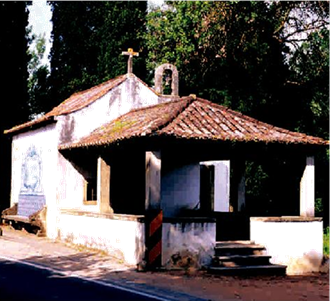
A 10 de Agosto de 1385, dia do mártir S. Lourenço, as hostes de D. João I juntaram-se neste local, às do Condestável D. Nuno Álvares Pereira, rumo a Aljubarrota.
A Capela e o Padrão assinalam o encontro e o santo, orago da ermida, deu o nome ao lugar.
Aires de Quental, encarregado de ali construir uma fábrica de armas, por D. Manuel, foi o edificador da Capela.
Morada:
Av. D. Nuno Álvares Pereira
2300-411 Tomar | PORTUGAL
São Lourenço Chapel
This was the spot where, on 10th August 1385, the day of the martyr S. Lourenço, the troops of D. João I joined those of Constable D. Nuno Álvares Pereira on their way to Aljubarrota.
The Chapel and Monument mark the meeting place and the patron saint of the Chapel gave his name to the place.
Aires de Quental, whom D. Manuel I had given the task of building a weapons factory there, also built the Chapel.
Capela de Santo António

Foi construída entre 1953 e 1955, mas contém elementos arquitetonicos de uma ermida renascentista cinco Séculos mais antiga - a Capela do Casal de Santo António, provavelmente de 1459, existente perto do Aqueduto dos Pegões. Em 1924, sob a égide da União dos Amigos dos Monumentos da Ordem de Cristo, procedeu-se ao desmantelamento controlado das cantarias da capela.
Em 1953, com a construção de um Bairro Social (hoje, 1º de Maio), edificou-se a capela atual com elementos arquitetónicos da original: portal principal e a capela-mor com nervuras. Entretanto, a União dos Amigos da Ordem de Cristo cedeu, do espólio de outras edificações demolidas, mais alguns elementos para enriquecer a obra: a rosácea, os sobrearcos das portas, as canmtarias renascença da porta de serviço e os azulejos hispano-árabes do altar provenientes da chaminé de um antigo prédio da Praça da República.
Morada:
Av. Dr. Egas Moniz
2300-436 Tomar | PORTUGAL
GPS:
39°36'30,6"N
8°24'21,8"W
Santo António Chapel
It was built between 1953 and 1955, but contains architectural elements of a Renaissance chapel. In 1953 , with the construction of a Housing Project, built up the current chapel with architectural elements of the original.
Igrejas
Igreja de Santa Maria do Olival

Templo gótico de meados do século XIII construído no sítio da antiga igreja templária erguida por D. Gualdim.
O Panteão dos Mestres Templários foi sede de nullius diocesis com jurisdição sobre as igrejas dos Descobrimentos. A interessante estrutura espacial de três naves serviu de modelo à igreja de São João Baptista e a outras igrejas do gótico final português.
No exterior, destaca-se a magnífica rosácea, a torre de atalaia adaptada a campanário, e a loggia do século XVI; no interior, a lápide de Gualdim Pais, o túmulo de D. Diogo Pinheiro e as imagens Nossa Senhora do Leite e Santas Mães.
Morada:
Rua Aquilles da Mota Lima
2300-255 Tomar | PORTUGAL
Horário
Inverno (Outubro a Abril):
Terça a Domingo, 10h00 às 12h00 e 14h00 às 17h00
Verão (Maio a Setembro):
Terça a Domingo, 10h00 às 13h00 e 15h00 às 18h00
Encerrado dias de feriado, 1 de janeiro, 1 de maio e 25 de dezembro
Santa Maria do Olival Church
Gothic temple from the mid 13th century built on the site of a former temple built by D. Gualdim Pais.
The Pantheon of the Masters of the Templars was the headquarters of the nullius diocesis with jurisdiction over the churches of the Discoveries.
The interesting spatial structure with three naves served as a model for the São João Baptista church and other churches from the end of the Portuguese gothic period. Outside, the magnificent rose window is noteworthy, the lookout tower converted into a bell tower and the 16th century loggia; inside, the tombstone of Gualdim Pais, the tomb of D. Diogo Pinheiro and the images of Our Lady of Milk and the Holy Mothers.
This Gothic church (13th century) was built as a burial ground for the Templar Knights. Gualdim Pais, the founder of the city, was buried in the church and his original tomb slab, dated from 1195 and bearing a gothic inscription, is still preserved inside.
Schedule
Winter (October to April):
Tuesday to Sunday, 10am to 12am and 2pm to 5pm
Summer (May to September):
Tuesday to Sunday, 10am to 13am and 3pm to 6pm
Closed on public holidays, Jan. 1, May 1 and Dec. 25
Igreja de São João Baptista
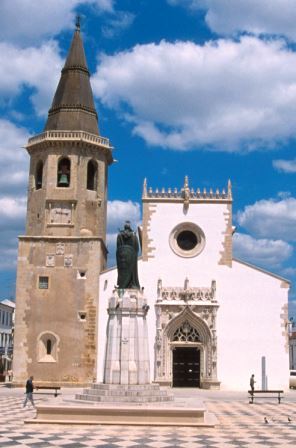
Templo de estilo gótico tardio, construído por ordem de D. Manuel I sobre anterior ermida da mesma evocação. Foi concluído no início do século XVI.
A simbólica de D, Manuel (Brasão Real, Esfera Armilar e Cruz de Cristo) está presente na torre e repete-se no púlpito e nos portais Poente e Norte.
No exterior destaca-se a Torre de três corpos, o Portal Principal, o Portal Norte e o Portal Sul, verosímil memória de um templo primitivo.
A estrutura espacial das naves é idêntica à da igreja de Santa Maria do Olival, enriquecida pelo púlpito da pedra lavrada e pela pintura quinhentista, expoente máximo da arte pictórica portuguesa do século XVI.
Morada:
Praça da República
2300-550 Tomar | PORTUGAL
Horário
Inverno (Outubro a Maio):
2ª Feira a Domingo, 10h00 às 12h00 e 14h00 às 17h00
Verão (Junho a Setembro):
2ª Feira a Domingo, 10h00 às 12h00 e 14h00 às 18h00
Encerrado dias de feriado, 1 de janeiro, 1 de maio e 25 de dezembro.
São João Baptista Church
Late gothic temple constructed on D. Manuel 1´s orders on top of the small chapel of the same name. It was completed at the beginning of the 16th century.
The symbology of D. Manuel (the Royal Coat of Arms, the Armillary Sphere and the Cross of Christ) are seen in the tower and again in the pulpit and the north and south portals.
On the outside is the tower with its three portals, the main one, the north and the south, reminiscent of an original temple.
The spatial structure of the naves is identical to that seen in the Santa Maria do Olival church and is enriched by the sculpted stone pulpit and the 16th century painting, the greatest exponent of 16th century Portuguese pictorial art.
The main church of Tomar is located in the main square of the town, in front of the Municipality (17th century) and a modern statue of Gualdim Pais. The church was built between the 15th and 16th centuries and has many interesting artistic details, like the flamboyant Gothic portal, the Manueline tower with a 16th century clock, the decorated capitals of the inner columns of the nave and several panels painted in the 1530s by one of Portugal's best Renaissance artists, Gregório Lopes.
Schedule
Winter (October to May):
Monday to Sunday, 10am to 12 am and 2pm to 5pm
Summer (June to September):
Monday to Sunday, 10am to 12 am and 2pm to 6pm
Closed on public holidays, Jan. 1, May 1 and Dec. 25.
Igreja da Misericórdia
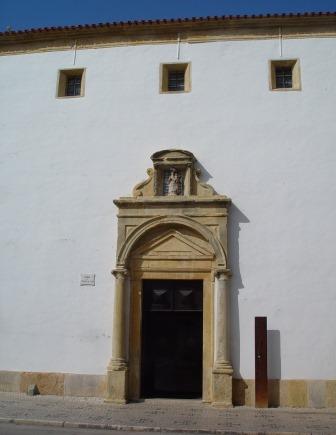
A Misericórdia de Tomar foi fundada pelo Rei D. Manuel I, em 1510.
A Igreja de Nossa Senhora da Graça, ou de Nossa Senhora da Cadeia é vulgarmente conhecida por Misericórdia. É uma construção maneirista edificada na segunda metade do século XVI.
A imagem da padroeira preenche o nicho que remata o elegante pórtico Quinhentista. A nave é decorada por molduras rectangulares de pedra e azulejos enxaquetados.
Realce para o Milagre Eucarístico de Santo António, em painel do século XVI.
O Hospital substituiu o de Nossa Senhora da Graça (século XV) resultante da unificação henriquina de todos os hospitais e hospícios que havia na Vila.
Morada:
Av. Dr. Cândido Madureira
2300-351 Tomar | PORTUGAL
Horário:
Temporariamente encerrada
Misericórdia Church
King D. Manuel I in 1510 founded the Misericordy of Tomar.
The church of Nossa Senhora da Graça, or Nossa Senhora da Cadeia, is popularly known as the Misericord. A mannerist construction built in the second half of the 16th century.
The image of the patron saint fills the niche which completes the elegant 16th century portico.
Rectangular stone frames and chequered tiles decorate the nave.
Of special interest is the 16th century panel showing the Eucharistic miracle of Saint Anthony.
The Hospital substituted the Nossa Senhora da Graça Hospital (15th century) as a result of Prince Henry’s unification of all the hospitals and hospices in the town.
Schedule:
Temporarily closed
Igreja e Convento de São Francisco
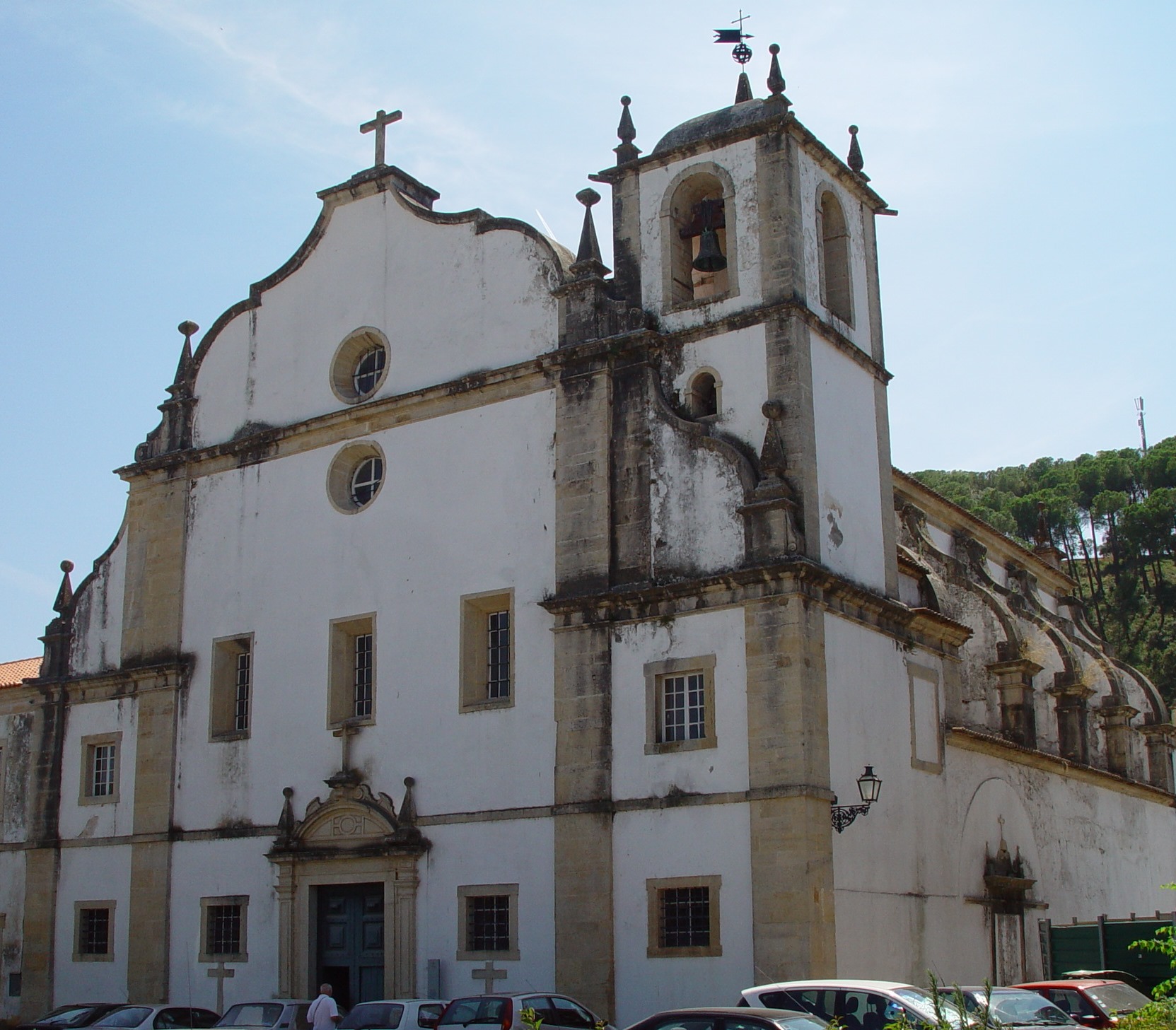
O Convento de São Francisco é um edifício maneirista construído em torno de dois claustros.
Em meados do século XVII substituiu a capela de Nossa Senhora dos Anjos. Acolheu a comunidade da então extinta casa de Santa Cita.
Templo do século XVII (1625-1660), característico da Arquitectura Chã. A fachada destaca o maneirismo do portal e do frontispício.
No interior, de uma só nave coberta a grande altura por uma abóbada de berço, realçam-se as esculturas de um raríssimo Calvário e as quatro representações pictóricas da Vida da Virgem.
Na primeira capela do lado do Evangelho sobressai a imagem de Santa Iria, padroeira da cidade de Tomar.
Morada:
Av. General Bernardo Faria
2300-000 Tomar | PORTUGAL
Horário:
10h00 às 12h00 e 14h00 às 17h00
Encerrado dias de feriado, 1 de janeiro, 1 de maio e 25 de dezembro.
São Francisco Convent and Church
The São Francisco Convent in a mannerist building set around two cloisters. It served the community after the Santa Cita house was closed.
In the mid 17th century it replaced the Nossa Senhora dos Anjos chapel.
A 17th century temple (1625-1660) is typical of Chã architecture. Mannerism is seen in the portal and the frontispiece of the façade.
On the inside, where a single nave is covered at great height by a barrel vault, are the sculptures of an extremely rare Calvary and the four pictorial representations of the life of the Virgin.
In the first chapel next to the Evangel, stands the image of Santa Iria, the patron saint of Tomar.
Schedule:
10am to 12am and 2pm to 5pm
Closed on public holidays, Jan. 1, May 1 and Dec. 25.






